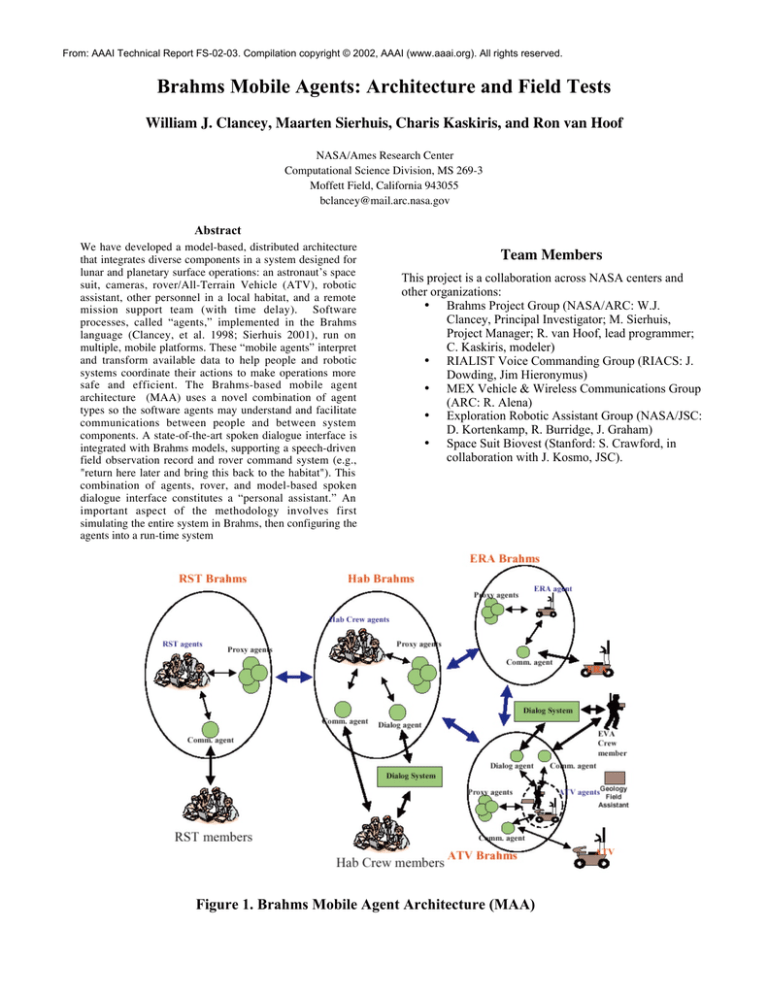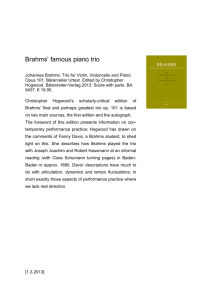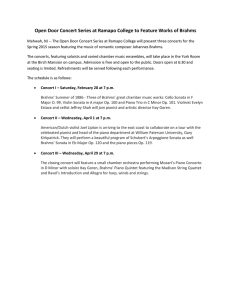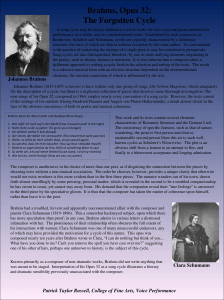
From: AAAI Technical Report FS-02-03. Compilation copyright © 2002, AAAI (www.aaai.org). All rights reserved.
Brahms Mobile Agents: Architecture and Field Tests
William J. Clancey, Maarten Sierhuis, Charis Kaskiris, and Ron van Hoof
NASA/Ames Research Center
Computational Science Division, MS 269-3
Moffett Field, California 943055
bclancey@mail.arc.nasa.gov
Abstract
We have developed a model-based, distributed architecture
that integrates diverse components in a system designed for
lunar and planetary surface operations: an astronaut’s space
suit, cameras, rover/All-Terrain Vehicle (ATV), robotic
assistant, other personnel in a local habitat, and a remote
mission support team (with time delay). Software
processes, called “agents,” implemented in the Brahms
language (Clancey, et al. 1998; Sierhuis 2001), run on
multiple, mobile platforms. These “mobile agents” interpret
and transform available data to help people and robotic
systems coordinate their actions to make operations more
safe and efficient. The Brahms-based mobile agent
architecture (MAA) uses a novel combination of agent
types so the software agents may understand and facilitate
communications between people and between system
components. A state-of-the-art spoken dialogue interface is
integrated with Brahms models, supporting a speech-driven
field observation record and rover command system (e.g.,
"return here later and bring this back to the habitat"). This
combination of agents, rover, and model-based spoken
dialogue interface constitutes a “personal assistant.” An
important aspect of the methodology involves first
simulating the entire system in Brahms, then configuring the
agents into a run-time system
Team Members
This project is a collaboration across NASA centers and
other organizations:
• Brahms Project Group (NASA/ARC: W.J.
Clancey, Principal Investigator; M. Sierhuis,
Project Manager; R. van Hoof, lead programmer;
C. Kaskiris, modeler)
• RIALIST Voice Commanding Group (RIACS: J.
Dowding, Jim Hieronymus)
• MEX Vehicle & Wireless Communications Group
(ARC: R. Alena)
• Exploration Robotic Assistant Group (NASA/JSC:
D. Kortenkamp, R. Burridge, J. Graham)
• Space Suit Biovest (Stanford: S. Crawford, in
collaboration with J. Kosmo, JSC).
Figure 1. Brahms Mobile Agent Architecture (MAA)
Scenario Architecture
In this generalized scenario, a Remote Science Team
(RST) oversees and advises surface operations that are
locally managed by crew members in the habitat. On the
surface, participating in an Extra-Vehicular Activity
(EVA), are the Exploration Robotic Assistant (ERA) and
crew members using ATVs and other tools. Brahms
software, represented by the ellipses, is running at the
location of the RST, in the hab, on board the ERA, and on
board one or more ATVs.
Brahms is a multiagent system, in which the
fundamental processes are “agents” organized into
“groups”; agents have “beliefs” and “activities” (see
Clancey, in press for comparison to task modeling). Each
Brahms system, running on these four (or more) platforms,
is configured with “personal” agents, representing the
interests and activities of corresponding people and
systems. For example, RST Brahms includes the agents
for the RST team; ERA Brahms includes an agent
representing the ERA rover.
Each Brahms system in the MAA includes two other
basic kinds of agents:
1. Communication Agent: People and objects in the real
world interact with Brahms agents through a
communication agent (see Figure 1). The Dialog Agent
is a type of communication agent allowing humans to
have conversations with other mobile agents.
2. Proxy Agents: Represent agents and objects residing in
other Brahms models; e.g., Hab Brahms includes an
ERA proxy agent. Local Brahms agents interact with
proxy agents in order to get or give information, as well
as to request or promise actions. Proxy Agents allow for
a seamless interaction between mobile agents even when
a mobile agent is out of communication range to interact
dynamically with the rest of the agents in the MAA.
The architecture is integrated through OAA messages,
KAoS (Bradshaw et al. 1997), and CORBA:
• An agent in one Brahms model communicates
with its proxy agent representation in another
model through the KAoS middleware layer.
• Because continuous communication cannot be
guaranteed, proxy agents represent the current
state of other models, and may trigger recovery
procedures if other agents are off line.
• Communication agents serve as interfaces
between Brahms and external machines (e.g., a
camera) using CORBA objects; as a special case,
dialog agents interface between Brahms and the
RIALIST speech system.
• Both communication agents and dialog agents are
Brahms external agents (interfacing with Brahms
through the Brahms API). For example, a
Communication Agent is needed on the
ATVBrahmsModel to interface with the MEX
agent (for GPS tracking, communication
equipment status, etc.).
The entire system shown in Figure 1 is first simulated in
Brahms. In addition to the components shown in the
ellipses, the people and external systems (e.g., ERA) are
also simulated. This simulation therefore includes:
o Simulated People
o Simulated Systems (e.g., ATV)
o Software Agents (runtime)
ß Personal Agents of people (e.g., RST agents) and
systems (e.g., ERA Agent, ATV Agent, Dialog
Agent)
ß Communication agents
ß Proxy agents
Field Tests
The first systems integration field test was completed at
NASA/Ames in April 2002. A “level 0” scenario integrated
the RIALIST speech dialogue system and a distributed
Brahms model running on the MEX ATV and a simulated
ERA robot, using the MEX wireless network. The next
field test was scheduled at JSC at the end of May, to
include the ERA robotic control software running onboard
the actual ERA robot.
The level 0 scenario demonstrated remote commanding
of the ERA by the EVA astronaut, using human speech.
The command to the ERA involves taking a still-picture of
the astronaut (“ERA take a picture of me”). The speech
dialogue system translates the human speech and
communicates the derived command to the astronaut’s
personal Brahms agent. The astronaut’s personal agent
derives the correct robot command and communicates it to
the ERA’s personal agent running onboard the ERA (over
the MEX wireless network), which in turn communicates
with the ERA using a CORBA interface. The ERA
executes the command and stores the image. The ERA’s
personal agent composes and stores the context of the
picture in the form of a picture meta-data object and
informs the EVA astronaut that the image has been taken,
using the speech dialogue system.
Besides testing the RIALIST/Brahms/MEX interface,
another objective of the field test was to apply a
“simulation to implementation” methodology using a
Brahms simulation model. This Use-Case method
(Jacobson 1994) uses a Brahms simulation model as an
agent- and object-based computational functional design of
the overall software and hardware system. The runtime
system replaces the simulated people and systems by their
corresponding actual entities. This approach allows us to
test a complete MAA system by simulating those elements
that are not yet implemented or included in a field test (e.g.
the robot).
Acknowledgments
Funding for this work is provided in part by the
NASA/Ames Intelligent Systems Program, HumanCentered Computing area, managed by Mike Shafto.
References
Bradshaw, J. M., Dutfield, S., Benoit, P., and Woolley, J.
D. 1997. "KAoS: Toward an industrial-strength generic
agent architecture." Software Agents, J. M. Bradshaw,
ed., AAAI Press/The MIT Press, Cambridge, MA, 375418.
Clancey, W. J., Sachs, P., Sierhuis, M., and van Hoof, R.
1998. Brahms: Simulating practice for work systems
design. International Journal of Human-Computer
Studies, 49: 831-865.
Clancey, W. J. (in press). Simulating activities: Relating
motives, deliberation, and attentive coordination.
Cognitive Systems Research. Special issue on situated
and embodied cognition.
Jacobson, I. 1994. Object-Oriented Software Engineering:
A Use Case Driven Approach, Addison-Wesley
Publishing Company, Reading, MA.





